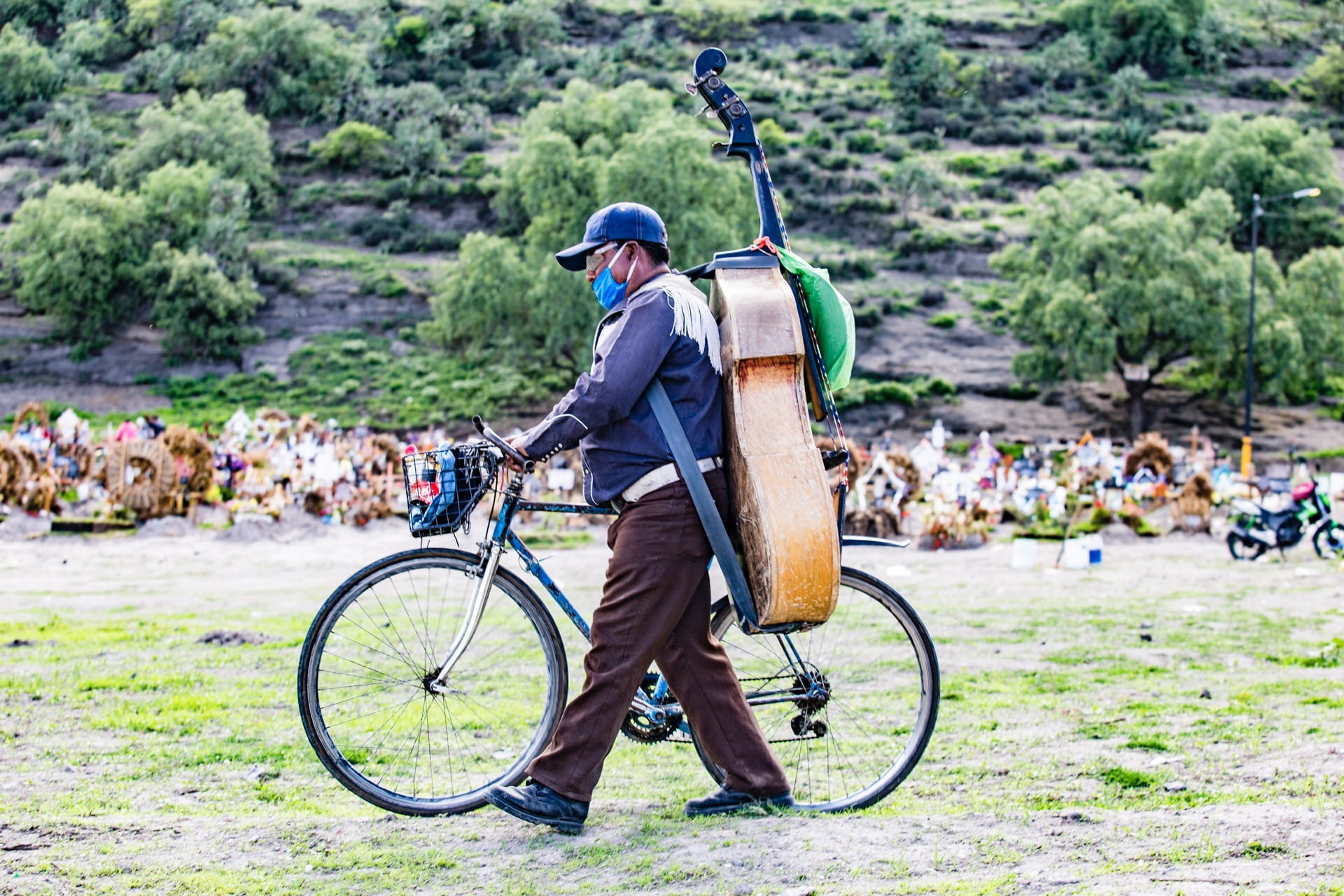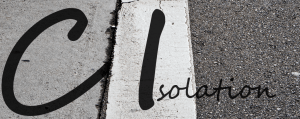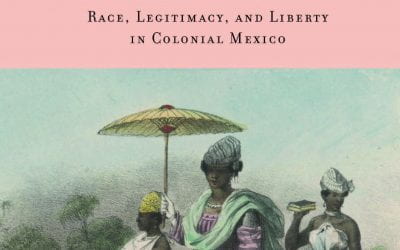Saying Goodbye in the Midst of a Pandemic
Two photos by Cristian Leyva were selected for the exhibit “Documenting the Impact of Covid-19 through Photography: Collective Isolation in Latin America,” curated in collaboration with ReVista and the Art, Culture, and Film program at Harvard’s David Rockefeller Center for Latin American Studies (DRCLAS.)
The exhibition, based on an Open Call for Photography launched in July 2020, aims to create a critical visual record of our unprecedented times so they can be remembered by future generations.

Músicos que acompañan el amargo dolor / Musicians accompanying the bitter pain. Municipal cementery of San Miguel Xico, Valle de Chalco, State of Mexico, México. This photo was chosen for the exhibition.
The Covid-19 pandemic has posed an enormous challenge, independently of one’s social group, playing havoc with many aspects of our lives, revealing the precariousness in which a great part of the world population lives, making visible the weaknesses in each country.
In particular, those of us who have covered the crisis as photjournalists have had a steep learning curve about keeping safe and healthy, as well as coming to value the importance of sharing in solidarity with our fellow journalists, creating network of coordination and support.
I arrived at the Xico pantheon in the Valle de Chalco precisely in that manner, thanks to a couple of colleagues who had developed a friendly relationship with the gravediggers and musicians that earned their living there, in this graveyard so typical of the rural areas in the State of Mexico.
In our country, the way in which we understand death is fundamental to our being; it is an element that can transcend death’s different conceptions, the context in which one lives, the faith that one professes; it is one of our most representative celebrations.
For many, cremation is just not an option because people believe it is necessary to visit their loved ones’ graves, because to die is a profoundly collective event, as important as being born, or perhaps even more so. At the moment of accompanying a loved one in the last moments, it is important that many friends, relatives and acquaintances come to the funeral, musicians included.
All this has been transformed because of the health crisis. Mourning has become more solitary; friends can not provide a shoulder to rest on or an embracing hug to the suffering, and although the music goes on, with masks for protection, its flavor is more somber, an audible accompaniment to digest grief.
The rural aspect of this cemetery makes me feel as if I were back in my community in the state of Guerrero. It is located at the bottom of a hill, and from there one can observe the Iztaccíhuatl and Popocatépetl volcanos; one of the cemetery’s sections still has rustic tombs, covered only by earth; one can see how as the cemetery has grown, it fills with newer tombs.

Las riesgosas despedidas de nuestros difuntos / The risky farewells of our deceased. This photo was chosen for the exhibition.
One can sit on the ground and contemplate the landscape for hours, for a moment I made time for this: to familiarize myself with the space, to chat with some gravediggers and musicians as they rested under the shade of a tree, waiting to earn a few pesos to resolve the economic needs of their families. They experience the funeral rites of burial in the cemetery, with very precarious and unguaranteed payments, working in unhealthy conditions because their families depend on them. They cannot stop. Neither does death.
Bit by bit, families—not in as large groups as usual—begin to arrive to bury their departed. The musicians approach them to offer their services; sometimes all goes well and they are contracted; in other cases, family religious beliefs do not permit this type of farewell and they are refused. At times I would rather listen to the songs than take photographs; they bring back memories of the farewells to some of my relatives. It is difficult not to be touched at the moment of the sound of the prayers, the music and the wails that accentuate further their pain because of the absence of the living.
I decided to wait for a bit more movement to be able to blend in and not be invasive in the face of the grief of the relatives. They are difficult moments, and I want to avoid disturbing and making people uncomfortable with the camera. The image in which a young woman can be seen saying farewell to her loved one was the most difficult one for me because of her clear pain, because the bitter moment has grown with the historic condition that we are experiencing.
Farewells now are more risky, especially for those who have lost a loved one to Covid-19. The solitude in which our relatives or friends pass away causes much pain for those of us who cannot accompany them, because of the impossibility of farewells, it’s necessary to offer a moment of calm, that moment in which one views the motionless body and understands, or begins to understand, the absence resonates in a monstruous fashion with the contrast of what these moments would usually be like, making the death even less comprehensible.
These two photographs seek to transmit this sensation, one that is difficult to explain in words, that one feels like an emptiness, a shadow without a body, a cry whose echo is not repeated, something that is missing, something like the popular expression that says, “there are the dead who do not make noise and the sorrow is even greater,” but at the same time, this sentiment is tied to a collective feeling with which we can identify because it is all too common and everyday.
At the end of the day, the musicians say goodbye to us. Some use bicycles to get around to save bus fare. It is then I choose to make my last photograph; I imagine the retreat as a daily sigh, a part of life that says farewell to us who are also leaving, to those who remain in “eternal peace.” The day and life in this space ends.
Decir adiós en medio de una pandemia
Por Cristian Leyva
Dos fotos de Cristian Leyva fueron seleccionado para la exposición, “Documentando el impacto de Covid-19 a través de la fotografía: Aislamiento colectivo en Latinoamérica”, auspiciado por ReVista y el Art, Culture, and Film program del David Rockefeller Center for Latin American Studies (DRCLAS) de Harvard.
La exposición, resultado de el concurso de fotografía anunciado en Julio 2020, busca crear un registro visual de estos tiempos sin precedentes y contribuir a nuestra futura memoria histórica.

Músicos que acompañan el amargo dolor / Musicians accompanying the bitter pain. Municipal cementery of San Miguel Xico, Valle de Chalco, State of Mexico, México. This photo was chosen for the exhibition.
La pandemia por Covid-19 ha significado un enorme desafío, sin importar grupo social al que pertenezcas, el impacto ha dejado grandes estragos en diversos aspectos de nuestras vidas y exhibiendo las precariedades en las que vive gran parte de la población mundial, visibilizando las debilidades de cada país.
En particular a quienes hemos cubierto desde el fotoperiodismo esta crisis, nos ha dejado aprendizajes para nuestro cuidado y seguridad, así como la importancia de compartir de manera solidaría con nuestros compañeros de trabajo, tejiendo redes de coordinación y apoyo.
Llegué al panteón de Xico en Valle de Chalco justamente así, gracias a un par de colegas que ya habían entablado una relación fraterna con los sepultureros y músicos que se ganan la vida en este lugar, un camposanto de características rurales en el Estado de México.
Es importante señalar que en nuestro país la forma en que se entiende la muerte es fundamental a la hora de hablar de identidad, es un elemento que puede trascender las distintas concepciones, el contexto en que se habite, la fé que se profese. Tan es así que el día de muertos, donde se recuerda y se realizan ofrendas, es una de las celebraciones más representativas que tenemos.
Para muchos la incineración no es una opción, justamente porque se cree que una tumba es necesaria para visitar a sus seres queridos, porque morir es un acontecimiento profundamente colectivo, tan importante como nacer, sino es que más. Al momento de acompañar a un ser querido a su última morada, es muy frecuente que un importante número de conocidos asista al velorio y al entierro, músicos incluidos.
Todo esto se ha transformado a partir de la crisis sanitaria. El duelo se ha vuelto más solitario, los amigos no pueden brindar su hombro ni su abrazo solidario a los dolientes, y aunque la música sigue, cubrebocas por medio, su sabor es más lúgubre, es la sonora compañía para digerir el dolor.
El aspecto rural del panteón me hizo sentir como si estuviera en mi comunidad, en el estado de Guerrero. Se encuentra al pie de un cerro y desde ahí es posible observar los volcanes Iztaccíhuatl y Popocatépetl; una de las secciones tiene todavía tumbas rusticas, solo cubiertas por la tierra; se aprecia cómo ha ido creciendo un poco más rápido dicha sección por la cantidad de tumbas recién hechas.

Las riesgosas despedidas de nuestros difuntos / The risky farewells of our deceased. This photo was chosen for the exhibition.
Uno puede sentarse en el suelo y contemplar el paisaje durante horas, por un momento me hice tiempo para ello: familiarizarme con el espacio, cruzar palabras con algunos sepultureros y músicos resguardados bajo la sombra de algún árbol, esperando a poder sacar algunos pesos para solventar los gastos de sus familias. Ellos viven diariamente los procesos fúnebres del entierro en los panteones, con pagos muy precarios y sin protección, tienen que trabajar en dichas condiciones insalubres, porque de ello dependen sus familias. Ellos no pueden detenerse. Tampoco lo hace la muerte.
Poco a poco familias no tan numerosas como sería lo normal, van llegando para enterrar a sus difuntos. Los músicos se acercan a ofrecer sus servicios, a veces les va bien y son contratados, en otros casos son familias cuyas creencias no permiten ese tipo de despedidas y son rechazados. Por momentos prefiero escuchar las canciones más que tomar fotografías, me llegan recuerdos de las despedidas de algunos de mis familiares. Me cuesta no ser tocado por el momento del sonido de los rezos, la música y el llanto que por la ausencia de vivos se acentúan más en su dolor.
Decidí esperar un poco más de movimiento para poder mimetizarme y no ser invasivo en el duelo de los familiares. Son momentos difíciles, lo que menos quiero es estorbar e incomodar con la cámara. La imagen en que se observa a una joven dando ese último adiós a su ser querido, fue la que más me costó hacer, por lo claro del dolor, porque el amargo momento se acrecentó con la condición histórica por la que estamos pasando.
Las despedidas de ahora son más riesgosas, sobre todo para los que han perdido a alguien por causas del Covid-19. La soledad en la que se esfuman nuestros familiares o amigos causa un gran dolor para quienes no podemos acompañarlos, por lo imposible de la despedida que habría de brindar un poco de calma, ese momento en que uno ve el cuerpo inerte y entiende, o comienza a entender, la ausencia resuena monstruosa por el contraste de lo que en otros momentos hubiera sido y se hace menos comprensible.
Estas dos fotografías buscan transmitir esa sensación, una que es difícil explicar mediante palabras, que se siente como un vacío, una sombra sin cuerpo, un grito cuyo eco no tiene réplica, como que algo falta, que se parece al dicho popular que dice que “hay muertos que no hacen ruido y es más grande su penar”, pero que a la vez está ligada al ser colectivo por lo fácil que es identificarnos con él, por lo común y cotidiano.
Al final del día, los músicos se despiden de nosotros, algunos usan la bicicleta como medio de transporte para ahorrarse lo del pasaje del camión. Es entonces que prefiero realizar una última fotografía, lo imagino alejarse como un suspiro cotidiano, una parte de la vida que se despide de nosotros que nos vamos también, de los que ahí se quedan al “descanso eterno”, se van el día y la vida en ese espacio.
Cristian Leyva is a Mexican photographer.
Cristian Leyva es fotográfo mexicano.
Related Articles
Editor’s Letter – Eyes on COVID-19
Editor's Letter Documenting Covid-19 It’s been two years, two months and some days since we published Olivia Liendo’s powerful article “With Covid-19, We are All Immigrants.” Relating how friends, family and strangers came together to help her mother in Venezuela...
A Review of The Rebel Scribe: Carleton Beals and the Progressive Challenge to U.S. Policy in Latin America
This is how the adventure of the 25-year-old from Kansas begins: “I began to dream dreams, extravagant dreams. I would stay here in this city of the Aztecs and the Conquistadors ..
A Review of The Capital of Free Women: Race, Legitimacy, and Liberty in Colonial Mexico
Ever since James Lockhart published Spanish Peru in 1968, historians of colonial Latin America have mined the notarial archives to illuminate the daily lives of people who were largely…






